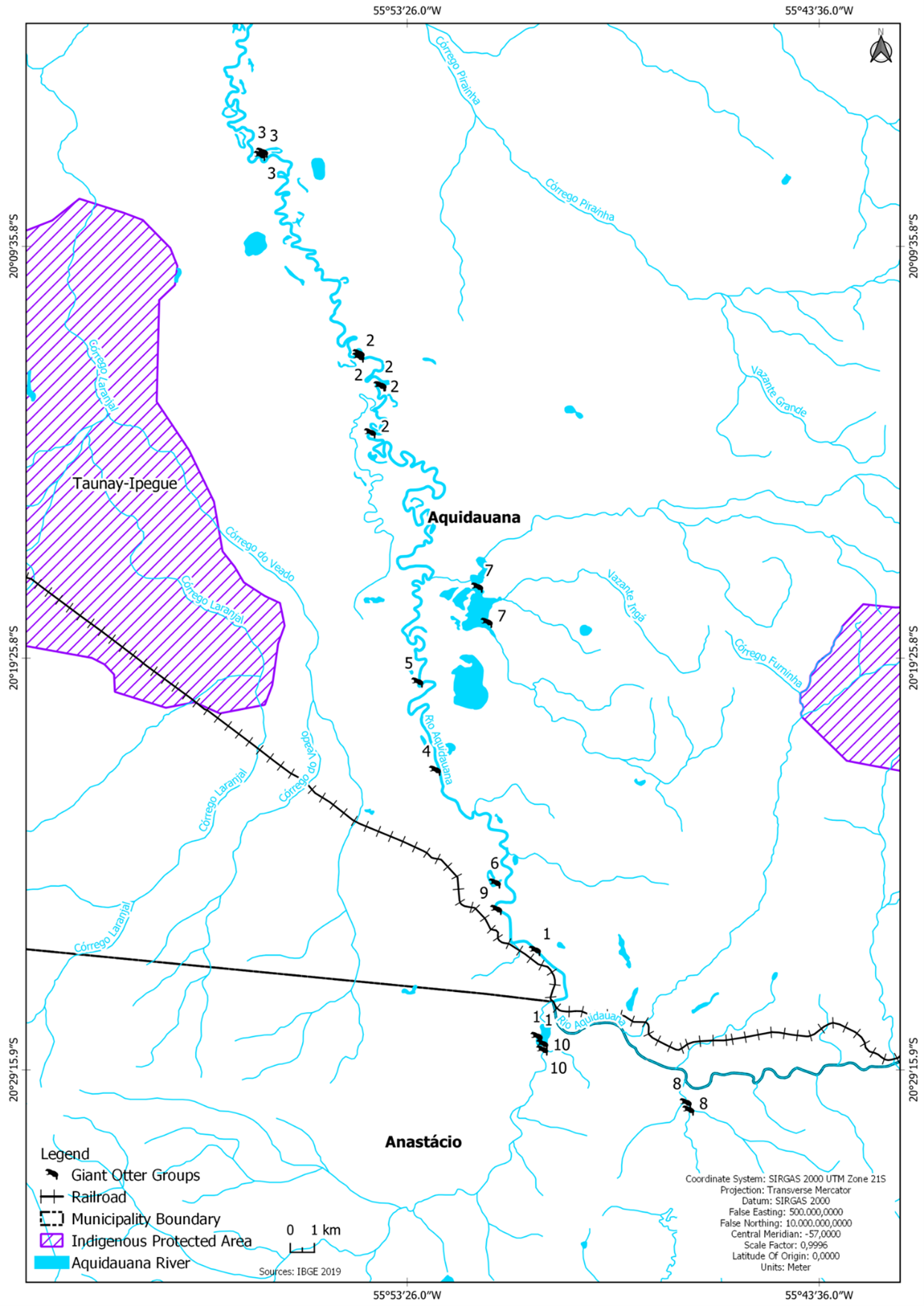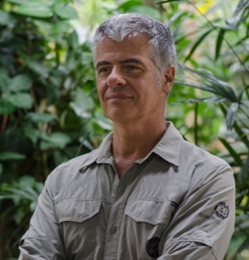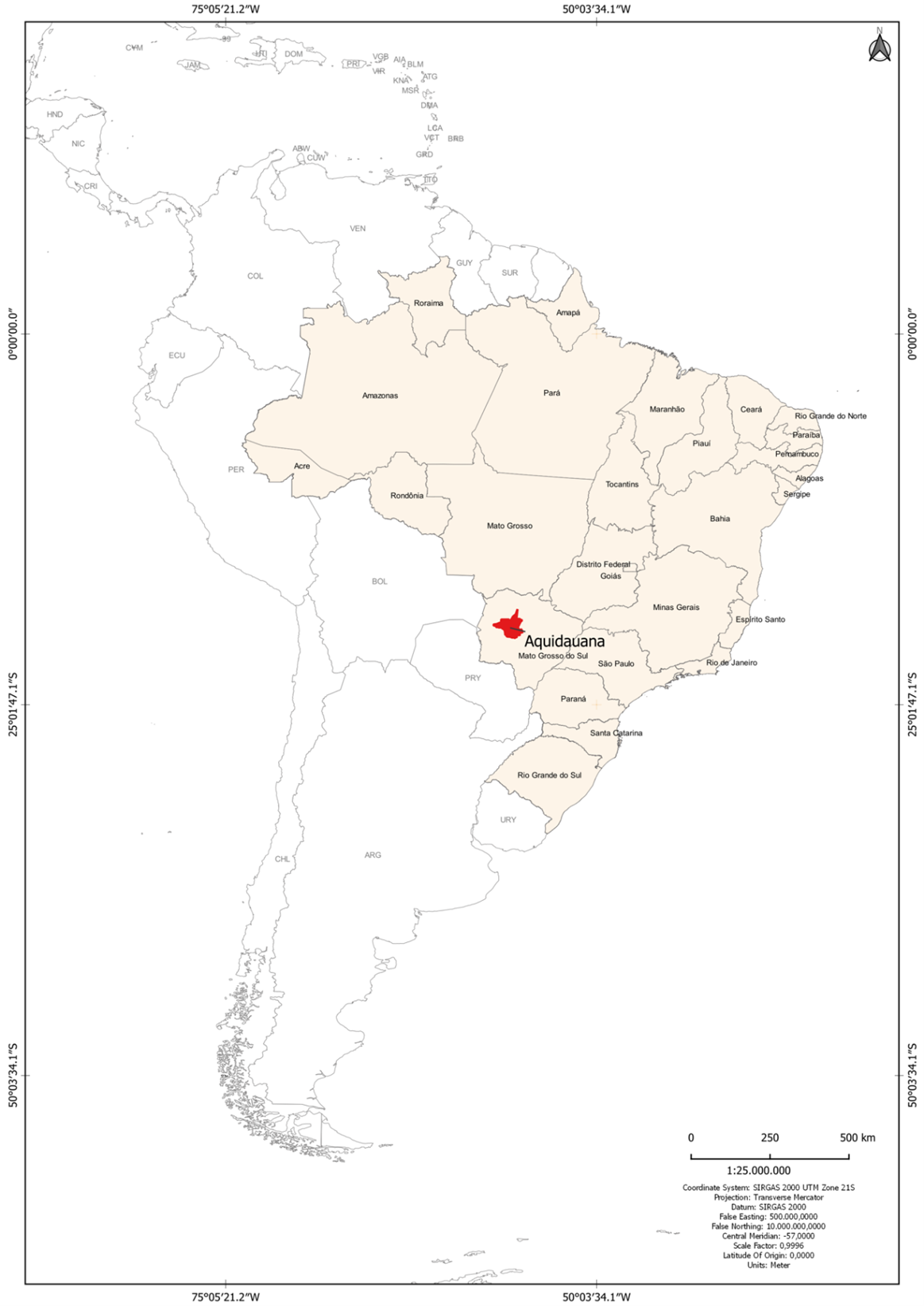IUCN/SSC Otter Specialist Group Bulletin

©IUCN/SCC Otter Specialist Group
Volume 39 Issue 3 (September 2022)
Citation: Junior, O.C., Birolo, A.B., Sabbagh, A., and Schmidt, A. (2022). Giant Otters (Pteronura brasiliensis) at the Aquidauana River. IUCN Otter Spec. Group Bull. 39 (3): 147 - 157
Giant Otters (Pteronura brasiliensis) at the Aquidauana River
Oldemar Carvalho Junior, Alesandra Bez Birolo, Anwar Sabbagh, and Andreoara Schmidt
Instituto Ekko Brasil, Caixa Postal 10121 - R. Henrique Veras do Nascimento, 82 - Conceição Lagoon - Florianópolis/SC - 88062-970
*Corresponding Author Email: ocjunior@ekkobrasil.org.br
(Received 2nd September 2021, accepted 16th April 2022)
Abstract: Pteronura brasiliensis is one of the two otters recorded in the Aquidauana River, Pantanal of Mato Grosso do Sul. The present study was carried out to map and catalog giant otter's groups' distribution from March to October 2014. Expeditions along the 120 km of the Aquidauana River were conducted, totaling 346.2 hours of observation. Altogether, more than 4 thousand km were covered within the 120 km study area, including bays and meanders. A 40 Hp motorboat was used to run on the main river for longer distances. Another 15 Hp motorboat was used for shorter distances. Finally, an electric motorboat was used in the bays along the river. A binocular with camera video - Bushnell 8x30 Mds and a binocular Ir optics 10x50 were used to observe and identify the giant otters' individuals. A GPS Garmin map 62s was used to register the coordinates. Photographic equipment consisted of a Canon Mark III 5D, with a 70-200 mm lens and a 100-400 mm lens. Photographs were used to take the pictures of the patterned patches on the throat of the animal. Satellite images were used to extract information and data from the study area. Forty direct observations of giant otters were obtained, 15 in the bays along the river, and 25 in the river. The average number of observed individuals ranged between 1 and 9. Ten different groups of giant otters were identified in the study area. Groups can be found in the main river and in the oxbow lakes along the river. The giant otters group catalog of the Aquidauana river can result in a positive impact on the citizens, contributing to public policies towards the conservation and protection of the species.
Keywords: Conservation tourism, threatened species, Pantanal, giant otter catalog
INTRODUCTION
This work’s main objective is to present the groups of giant otters living in the Aquidauana river. There are few studies regarding giant otters in the Aquidauana River. Tomas et al. (2000) found 30 groups of giant otters along 258 km of the river during a survey of 18 days in 2000. Each group was distributed along 10.8 km of the river. However, the groups were not identified. For the first time, the distribution and identification of the groups are defined in this river. In this work, 120 km of the river was monitored. The main objective was to identify and understand the number of giant otter groups in the study area, underpinning public policies and social mobilization to conserve the species.
The Aquidauana River is part of the Paraguay’s watershed that drains an area of 1,1 million of km2. It is a calm water environment without many rapids, which favors high productivity and, therefore, a higher concentration of fish. Food availability affects the success and distribution of giant otter groups (Carter and Rosas, 1997; Tomas et al., 2015). Carvalho Junior (2017) highlights that the giant otter is part of a complex energy network, including the environmental and economic system. The presence of groups of giant otters are impermanent and dynamic, reflecting the health of the system in a time delay. The giant otter, as the top of the trophic chain, depending on the various energy paths within the system, may reflect the past or current impact, only in the future, due to the trophic cascade (Jorge et al., 2013; Terborgh and Estes, 2013; Galetti et al., 2017).
Pantanal houses one of Brazil's largest populations of giant otters (Tomas et al., 2015), but, at the same time, with serious conflicts with fishermen and deforestation of marginal areas along the river, close to urban centers. The estimated population in the Pantanal is believed to be reaching it carrying capacity in some areas (Leuchtenberger and Mourão, 2008; Ribas et al., 2012). However, this might not be what reality shows, but just a picture of a moment of the timeline (Bogoni et al., 2020; Portela and Dirzo, 2020).
Predatory tourism and conflicts with fishermen are preoccupying (Tomas et al., 2000; Carvalho Junior et al., 2017; Carvalho Junior and Birolo, 2022). As a top predator, the species can be responsible for the carbon stock into the ecosystem due to the cascade effect on the trophic chain, and this is one of the reasons why the specie is not a good health indicator in the timeline. Not to mention the threats that the Pantanal Biome faces with the proliferation of hydroelectric plants, waterway projects for grain transport, expansion of agricultural areas, such as soy cultivation, in addition to climate change (Alho, 2008; Bergier and Resende, 2010; Silva et al., 2015; Observatório Pantanal, 2020).
Pantanal is well known by its pulse, characterized by a dry and rainy season (Silva et al., 2015). The groups’ territory size may be affected by drivers and pressures of change by the river basin (Utreras et al., 2005; Leuchtenberger et al., 2013; Leuchtenberger et al., 2015; Carvalho Junior and Birolo, 2022). In seasonally flooded areas, the space used by giant otters can be affected by water level oscillations and pulses (Duplaix et al., 2015).
Giant otter represents an important environmental asset, as a flag species, for the development of conservation tourism and protection of aquatic ecosystems (Carvalho Junior et al., 2017). On the other hand, there is a negative perception that certain sectors of society have about the species, such as fishermen and fish farmers who see the giant otter as a competitor (Staib and Schenck, 1994; Barocas et al., 2021; Carvalho Junior and Birolo, 2022).
The presence of groups of giant otters, close to Aquidauana and Anastácio, may represent the beginning of a community-based conservation tourism program. This could change the adverse reality in which the specie is seen as a competitor to be eliminated by man and become an ally to promote the local economy. This research hope to contribute to the application of public policies aimed at the development of sustainable community-based tourism in the region with biodiversity conservation.
METHODS
From March to October 2014, 83 expeditions along the 120 km of the Aquidauana River, Mato Grosso do Sul state, were conducted, totaling 346.2 hours of observation (Figure 1). More than 4 thousand kilometers were carried out, within the 120 km study area. The trips usually started at 7:00 hours in the morning, finishing at 18:00 hours in the afternoon.
Three boats were used. A bigger boat (Fishing Marajó 17 feet - 40 Hp motor) was used to run on the main river for more considerable distances with five people's capacity. A smaller boat for three people, with 15 Hp motor, was used for shorter distances and access some bays from the river. A third one, for two people, was used in the bays along the river, with an electric motor and two batteries, allowing 2 hours of navigation. A binocular with camera video - Bushnell 8×30 Mds and a classical binocular Ir optics 10×50, were used to observe and identify the giant otters' individuals. Navigation of the main course of the river was made at a constant speed of 10 - 15 km/h. A GPS Garmin map 62s was used to register the coordinates. Photographic equipment consisted of a Canon Mark III 5D, with a 70 - 200 mm lens and a 100 - 400 mm lens. Photographs were used to take the pictures of the patterned patches on the throat of the animal.
Satellite images were used to extract information and data from the study area. The images used in the Aquidauana River region were obtained free of charge from INPE's image catalog (Image catalog: http://www.dgi.inpe.br/CDSR/ Source: National Institute of Space Research). The main criteria used for the choice of scenes were based on the date of the most recent images, with little or no presence of clouds and recorded simultaneously. The methodological procedures applied to the images consisted of applying different image processing: a visual interpretation for identification of the image component classes, enhancement of the contrast, and classification. All files were adjusted according to the geographic coordinate system adopted in the project: South American Datum, 1969.
Groups of giant otters, identified in the study area, were plotted in the images as a particular class. Each group was identified by photographs taken in the field. The coordinate locations were plotted for each identified group, and the distances were calculated, having the Aquidauana bridge as a reference. The distance matrix was generated by vector analysis of the distance between points calculated by QGIS software. From the photograph, a draw was made, thanks to the software CorelDRAW X8, creating a figure pattern to have a catalog of the identified individuals.
RESULTS
Forty direct observations of giant otters were obtained, 15 in the bays along the river, and 25 in the river. The average number of observed individuals per event ranged between 1 and 9 (mean=3,6 ± 1,9). Forty-six locations with giant otter indirect signs such as dens, campsites, trails, resting, and marking sites were also recorded. Ten different groups of giant otters were identified in the study area, but only five could be sighted more than once. Furthermore, on thirteen occasions (38% of sightings), it was not possible to observe the throat marks and, consequently, it was not possible to identify the group. Only one of the groups observed within a bay was also observed in the river. Table 1 shows the ten groups' coordinates and the number of individuals for each group.
Figure 2 presents the spatial distribution of identified groups within the study area. Groups 1, 8, and 10 represent the closest groups of Aquidauana City, ranging from 2.6 to 6.5 km. Two of these groups are in a near bay, and the other one is in the Taquaruçu River, a close tributary of the Aquidauana River.

On average, the distance between the points of giant otters and the urban center was 22.7 km (± 14.5), with a minimum of 1.1 km. Identifying the ten groups and distributing them linearly along the 120 km of the river, resulted in 1 group of a giant otter every 12 km. The ten groups identified along the Aquidauana River are shown in Figure 3. Patches on the throat of the animal are different for each group. Some groups present more than one individual with different patches. In Figure 3, the dominant individual or the one who was more evident from the others was considered.

DISCUSSION
Distance interval between groups agrees with a census-based on one expedition of 18 days, along 324 km of river, from Aquidauana City to Passo do Lontra, that found one group of the species for each 10.8 km (Tomas et al., 2000). In other rivers, with similar size to the Aquidauana River, in Pantanal, as well as in Suriname and the Brazilian Amazon, several authors found a linear distribution varying from 2 to 12 km (Duplaix, 1980; Laidler, 1984; Leuchtenberger and Mourão, 2008; Evangelista and Rosas, 2011; Leuchtenberger et al., 2015).
In the Aquidauana River, groups of giant otters can be found in the main river and the river's oxbow lakes. The species was found in the main river where the mean depth was between 5 and 7 meters, and the velocity of the river ranged between 0.56 to 0.8 m.s-1. Other authors found giant otters in similar depths (Staib, 2005; Carrera-Ubidia, 2006; Evangelista and Rosas, 2011).
Published papers do not mention or describe in detail perpendicular movements of Pteronura brasiliensis regarding the longitudinal axis of the river. During the rainy season, the giant otters might disperse laterally looking for fish and dry areas through the forest (Duplaix, 1980; Utreras et al., 2005; Leuchtenberger et al., 2013; Leuchtenberger et al., 2015). Leuchtenberger et al., 2013 mentions the use of freshwater ponds and artificial ponds beside roads during the dry season in the Vermelho and Miranda rivers. In the present work, it was common to observe the species walking along the margins and on the riverbanks. It was also found that isolated bays, separated from the Aquidauana river by natural geographic barriers, are equally frequented during the dry season.
Only one of the groups observed within a bay was also observed in the river. Groups found in the bays may remain longer in these places, moving little to the main watercourse. Therefore, bays along the Aquidauana River can have greater ecological importance in preserving the giant otter in the area. It is possible to say that the species can walk considerable distances from the river to reach a bay or another watercourse. It is essential to consider that during the high flood pulse, it can be challenging to define the main river course in many areas. During this period, the species can travel away from the main course, making them more challenging to be sighted (Leuchtenberger et al., 2013).
The nearest bay to Aquidauana and Anastácio cities where the species was found is the Acogo, next to a slaughterhouse. Many giant otter sightings are within 5 km from the center of Aquidauana City. However, most encounters did not last for more than a few minutes, as the animals would quickly swim away and be out of sight. Reports from locals indicate that they are often harassed by people or by the boat noise.
As expected, the dry season is favored to obtain records of giant otter presence, which reinforces the importance of conducting more intense monitoring at this time of year. Most of the direct observations of giant otters were made downstream of Aquidauana city. In August 2014, a couple of giant otters were recorded upstream of the bridge connecting the two cities (Aquidauana and Anastácio). This couple, so close to town, shows the importance of long-term monitoring of giant otter populations in the study area, because the sites used by the species can vary throughout the year, according to the seasonal dynamics of flood pulse in the region.
The giant otter group catalog of the Aquidauana river can result in a positive impact on the citizens, contributing to public policies towards the conservation and protection of the species. To protect, it is crucial to know and learn about the subject. The catalog, associated with information about the species, can be used in the local schools, providing teachers and students with information about a local species. It is also essential for developing conservation tourism and ecotourism in the region.
REFERENCES
Alho, C.J.R. (2008). Biodiversity of the Pantanal: Response to seasonal flooding regime and to environmental degradation. Brazilian Journal of Biology, 68(4), 957-966. https://doi.org/10.1590/S1519-69842008000500005
Barocas, A., Farfan, J., Groenendijk, J., Mendoza, J., Silva, J., Mujica, O., Ochoa, J.A., Macdonald, D.W., Swaisgood, R.R. (2021). Disturbance-specific behavioral responses of giant otters exposed to ecotourism and extractive activities. Animal Conservation, 25(1): 15-26. https://doi.org/10.1111/acv.12713
Bergier, I., Resende, E.K. (2010). Dinâmica de cheias no Pantanal do rio Paraguai de 1900 a 2009. Anais 3o Simpósio de Geotecnologias No Pantanal, 35–43. https://www.geopantanal.cnptia.embrapa.br/2010/cd/p147.pdf
Bogoni, J.A., Peres, C.A., Ferraz, K.M.P.M.B. (2020). Effects of mammal defaunation on natural ecosystem services and human well being throughout the entire Neotropical realm. Ecosystem Services, 45, 101173. https://doi.org/10.1016/j.ecoser.2020.101173
Carrera-Ubidia, P. M. (2007). Giant otters (Pteronura brasiliensis) and humans in the lower Yasuní Basin, Ecuador: Spacio-temporal activity patterns and their relevance for conservation. Oregon State University. https://ir.library.oregonstate.edu/concern/parent/4b29bb002/file_sets/tb09j972m
Carter, S.K., Rosas, F.C.W. (1997). Biology and conservation of the Giant Otter Pteronura brasiliensis. Mammal Review, 27(1), 1-26. https://doi.org/10.1111/j.1365-2907.1997.tb00370.x
Carvalho Junior, O. de O., Silva, Carolina, Pereira, W., Fonseca, V.C., Birolo, A.B. (2017). Environmental accounting of natural capital and ecosystem services for the Aquidauana River, Southern Pantanal, Brazil. Wulfenia, 24(9). https://www.researchgate.net/publication/319852453_Environmental_accounting_of_natural_capital_and_ecosystem_services_for_the_Aquidauana_River_Southern_Pantanal_Brazil
Carvalho Junior, O., Birolo, A.B. (2022). Evaluation of Giant and Neotropical Otter as environmental assets in Conservation Tourism based on emergy analysis. Journal of Sustainable Tourism and Entrepreneurship, 2(4), 253-265. https://doi.org/10.35912/joste.v2i4.814
Duplaix, N. (1980). Observations on the ecology and behavior of the giant river otter Pteronura brasiliensis in Suriname. Revue d’Ecologie, Terre et Vie, 34 (4): 495-620. https://hal.archives-ouvertes.fr/hal-03529307/document
Duplaix, N., Evangelista, E., Rosas, F. C. W. (2015). Advances in the study of giant otter (Pteronura brasiliensis): Ecology, behavior, and conservation: a review. Latin American Journal of Aquatic Mammals, 10(2): 75-98. https://doi.org/10.5597/lajam00200
Evangelista, E.R., Rosas, F.C.W. (2011). The Home Range and Movements of Giant Otters (Pteronura brasiliensis) in the Xixuan Reserve, Roraima, Brazil . Proceedings of Xth International Otter Colloquium, IUCN Otter Spec. Group Bull. 28A: 31 – 37 https://www.iucnosgbull.org/Volume28A/Evangelista_Rosas_2011a.html
Galetti, M., Pires, A.S., Brancalion, P.H.S., Fernandez, F.A.S. (2017). Reversing defaunation by trophic rewilding in empty forests. Biotropica, 49(1): 5-8. https://doi.org/10.1111/btp.12407
Jorge, M.L.S.P., Galetti, M., Ribeiro, M.C., Ferraz, K.M.P.M.B. (2013). Mammal defaunation as surrogate of trophic cascades in a biodiversity hotspot. Biological Conservation, 163: 49-57. https://doi.org/10.1016/j.biocon.2013.04.018
Laidler, P.E. (1984). The Behavioural Ecology of the Giant Otter in Guyana. University of Cambridge.
Leuchtenberger, C., Mourão, G. (2008). Social Organization and Territoriality of Giant Otters (Carnivora: Mustelidae) in a Seasonally Flooded Savanna in Brazil. Sociobiology, 52(2): 257-270.
Leuchtenberger, C., Oliveira-Santos, L.G.R., Magnusson, W., Mourão, G. (2013). Space use by giant otter groups in the Brazilian Pantanal. Journal of Mammalogy, 94(2): 320–330. https://doi.org/10.1644/12-MAMM-A-210.1
Leuchtenberger, C., Magnusson, W.E., Mourão, G. (2015). Territoriality of Giant Otter Groups in an Area with Seasonal Flooding. PLOS ONE, 10(5), e0126073. https://doi.org/10.1371/journal.pone.0126073
Observatório Pantanal. (2020, October 26). Quatro municípios do Pantanal estão entre os 10 com mais focos de incêndios do país em 2020. Observatorio Pantanal. https://observatoriopantanal.org/2020/10/26/quatro-municipios-do-pantanal-estao-entre-os-10-com-mais-focos-de-incendios-do-pais-em-2020/
Portela, R. de C.Q., Dirzo, R. (2020). Forest fragmentation and defaunation drive an unusual ecological cascade: Predation release, monkey population outburst and plant demographic collapse. Biological Conservation, 252, 108852. https://doi.org/10.1016/j.biocon.2020.108852
Ribas, C., Damasceno, G., Magnusson, W., Leuchtenberger, C., Mourão, G. (2012). Giant otters feeding on caiman: Evidence for an expanded trophic niche of recovering populations. Studies on Neotropical Fauna and Environment, 47(1): 19-23. https://doi.org/10.1080/01650521.2012.662795
Silva, C.J., Silva Sousa, K.N., Ikeda-Castrillon, S.K., Lopes, C.R.A.S., da Silva Nunes, J.R., Carniello, M.A., Mariotti, P.R., Lazaro, W.L., Morini, A., Zago, B.W., Façanha, C.L., Albernaz-Silveira, R., Loureiro, E., Viana, I.G., Oliveira, R.F. de, Alves da Cruz, W.J., de Arruda, J.C., Sander, N.L., de Freitas Junior, D.S. Jongman, R.H.G. (2015). Biodiversity and its drivers and pressures of change in the wetlands of the Upper Paraguay-Guaporé Ecotone, Mato Grosso (Brazil). Land Use Policy, 47: 163-178. https://doi.org/10.1016/j.landusepol.2015.04.004
Staib, E., Schenck, C. (1994). Giant Otters and Ecotourism in Peru. IUCN Otter Spec. Group Bull., 9: 7–8. https://www.iucnosgbull.org/Volume9/Staib_Schenk_1994.html
Staib, E. (2005). Eco-etología del Lobo de Rio (Pteronura brasiliensis) en el sureste del Perú. Ayuda para Vida Silvestre Amenazada, Sociedad Zoológica de Francfort Perú.
Terborgh, J., Estes, J.A. (2013). Trophic Cascades: Predators, Prey, and the Changing Dynamics of Nature. Island Press.
Tomas, W., Borges, P.A.L., Florez, H.J., Filho, R.S., Júnior, F.K., Udry, V. (2000). Potencial dos rios Aquidauana e Miranda no Pantanal de Mato Grosso do Sul para a conservação da ariranha. III Simpósio sobre Recursos Naturais e Sócio-econômicos do Pantanal; 2000, 12. http://www.cpap.embrapa.br/agencia/congresso/Bioticos/TOMAS-073.pdf .
Tomas, W., Camilo, A., Ribas, C., Leuchtenberger, C., Mourão, G., Borges, P., Pellegrin, L. (2015). Distribution and conservation status of giant otter Pteronura brasiliensis in the Pantanal wetland, Brazil. Latin American JJournal of Aquatic Mammals, 10: 107. https://doi.org/10.5597/lajam00202
Utreras, V., Suárez E.R., Zapata-Ríos, G., Lasso, G., Pinos, L. (2005). Dry and rainy season estimations of giant otter, Pteronura brasiliensis, home range in the Yasuní National Park, Ecuador. Latin American Journal of Aquatic Mammals, 4(2): 191-194. https://doi.org/10.5597/lajam00085
Résumé: Loutres Géantes (Pteronura brasiliensis) à la Rivière Aquidauanal
Pteronura brasiliensis est l ’une des deux espèces de loutres répertoriées dans la rivière Aquidauana, au Pantanal du Mato Grosso do Sul. La présente étude a été réalisée de mars à octobre 2014 pour cartographier et estimer la distribution des groupes de loutres géantes. Des campagnes de terrain ont été menées le long des 120 km de rivière de l’Aquidauana, totalisant 346,2 heures d ’observation. Au total, plus de 4.000 km ont été parcourus dans la zone d ’étude de 120 km, y compris les baies et les méandres. Un bateau à moteur de 40 CV a été utilisé pour naviguer sur le cours principal de la rivière sur les plus longues distances. Un autre bateau à moteur de 15 CV a été utilisé pour des distances plus courtes. Enfin, un bateau à moteur électrique a été utilisé dans les baies le long du fleuve. Des jumelles avec caméra vidéo - Bushnell 8x30 Mds et Ir optique 10x50 ont été utilisées pour observer et identifier les individus de loutres géantes. Une carte GPS Garmin 62s a été utilisée pour enregistrer les coordonnées. Le matériel photographique consistait en un Canon Mark III 5D, avec un objectif 70-200 mm et un objectif 100-400 mm. Des photos ont été utilisées afin d’avoir les motifs des taches de la gorge de l ’animal. Des images satellites ont permis d’extraire des informations et des données de la zone d ’étude. Quarante observations directes de loutres géantes ont été obtenues, 15 dans les baies le long du fleuve, et 25 dans le fleuve. Le nombre moyen d ’individus observés variait entre 1 et 9. Dix groupes différents de loutres géantes ont été identifiés dans la zone d ’étude. Des groupes peuvent être trouvés dans le cours principal ainsi que dans les bras morts le long de la rivière. L’inventaire du groupe de loutres géantes de la rivière Aquidauana peut avoir un impact positif sur les citoyens, contribuant aux politiques publiques de conservation et de protection de l ’espèce.
Revenez au dessus
Resumen: Nutrias Gigantes (Pteronura brasiliensis) en el Río Aquidauana
Pteronura brasiliensis es una de las dos nutrias registradas en el Río Aquidauana, Pantanal de Mato Grosso do Sul. El presente estudio fue llevado a cabo para mapear y catalogar la distribución de los grupos de nutrias gigantes desde Marzo hasta Octubre de 2014. Fueron conducidas expediciones a lo largo de 120 km del Río Aquidauana, totalizando 346.2 horas de observación. En total, fueron cubiertos más de 4 mil km dentro del área de estudio de 120 km, incluyendo bahías y meandros. Se utilizó un bote a motor de 40 Hp para desplazarnos por el río principal a distancias mayores. Utilizamos otro bote a motor de 15 Hp para distancias más cortas. Finalmente, usamos un bote a motor eléctrico para las bahías a lo largo del río. Se utilizaron un binocular con videocámara - Bushnell 8x30 Mds y un binocular Ir optics 10x50 para observar e identificar los individuos de nutria gigante. Se utilizó un GPS Garmin map 62s para registrar las coordenadas. El equipamiento fotográfico consistió en una Canon Mark III 5D, con una lente 70-200 mm y una 100-400 mm. Se utilizaron las fotografías para extraer información y datos del área de estudio. Se obtuvieron cuarenta observaciones directas de nutrias gigantes, 15 en las bahías a lo largo del río, y 25 en el río. El número promedio de individuos observados estuvo entre 1 y 9. Identificamos diez grupos diferentes de nutrias gigantes en el área de estudio. Los grupos se pueden encontrar en el río principal y en los lagos de herradura a lo largo del río. El catálogo de los grupos de nutrias gigantes del río Aquidauana puede resultar en un impacto positivo en los ciudadanos, contribuyendo a las políticas públicas tendientes a la conservación y protección de la especie.
Vuelva a la tapa
Resumo: Ariranhas (Pteronura brasiliensis) no Rio Aquidauana
Pteronura brasiliensis é uma das duas espécies de lontras registradas no Rio Aquidauana, Pantanal de Mato Grosso do Sul. O presente estudo foi realizado para mapear e catalogar a distribuição dos grupos de ariranhas no período de março a outubro de 2014. Foram realizadas expedições ao longo de 120 km do Rio Aquidauana, totalizando 346,2 horas de observação. Ao todo, foram percorridos mais de 4 mil km na área de estudo de 120 km, incluindo baías e meandros. Uma lancha de 40 Hp foi usada para percorrer o rio principal por distâncias maiores. Outra lancha de 15 Hp foi utilizada para distâncias mais curtas. Por fim, uma lancha elétrica foi utilizada nas baías ao longo do rio. Um binóculo com câmera de vídeo - Bushnell 8 × 30 Mds e um binóculo ótico Ir 10 × 50 foram usados para observar e identificar os indivíduos das ariranhas. Um mapa GPS Garmin 62s foi usado para registrar as coordenadas. O equipamento fotográfico consistia em uma Canon Mark III 5D, com uma lente de 70 – 200 mm e uma lente de 100 – 400 mm. Fotografias foram usadas para registrar as fotos das manchas estampadas na garganta do animal. Imagens de satélite foram usadas para extrair informações e dados da área de estudo. Foram obtidas 40 observações diretas de ariranhas, 15 nas baías ao longo do rio e 25 no rio. O número médio de indivíduos observados variou entre 1 e 9. Dez grupos diferentes de ariranhas foram identificados na área de estudo. Os grupos podem ser encontrados no rio principal e nos lagos marginais ao longo do rio. O catálogo do grupo de ariranhas do rio Aquidauana pode resultar em impacto positivo para os cidadãos, contribuindo para políticas públicas de conservação e proteção da espécie..
Vuelva a la tapa




